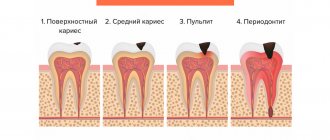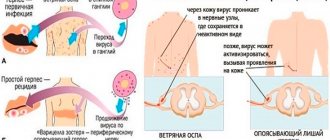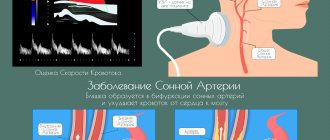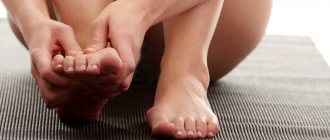Forms and complications of rosacea
Previously, several subtypes of the disease were identified according to the most pronounced skin changes: erythematotelangiectatic; papulopustular; phymatous; ophthalmic The updated guidelines suggest an individualized approach by assessing a patient's specific pattern of skin changes.
Previously, conditions such as phyma (tissue thickening, usually on the skin of the nose) and eye lesions (ophthalmic rosacea) were considered complications of the disease. Currently, they are assessed in a complex of identified changes.
Clinical manifestations of rosacea
Erythema and telangiectasia with rosacea on the face most often appear on the cheeks and forehead, inflammatory papules and pustules are observed mainly in the nose, forehead and cheeks ( Fig. 1 ). extrafacial lesions can occur in the neck and upper third of the chest.
Rice . 1. Rosacea in women (Danish national service on dermato-venereology)
https://www.danderm-pdv.is.kkh.dk/atlas/4-136.html
When the lesion affects the sebaceous glands, rhinophyma , a thickened and misshapen nose, can occur. Moreover, in some cases, rhinophyma appears in isolation, without other clinical signs of rosacea.
Injection of conjunctival vessels for the ophthalmic type of rosacea causes a red tint to the eyes. As the disease progresses, chalazion (chronic proliferative inflammation of the cartilage of the eyelid and the edge of the eyelid around the meibomian gland) or episcleritis (inflammation of the episcleral tissue lying between the conjunctiva and sclera) may occur.
, the Global Rosacea Consensus Panel recommended a classification according to which at least one or two primary criteria must be present to make a diagnosis:
- Diagnostic criteria:
- Permanent centrofacial erythema of a characteristic appearance, with periodic exacerbations.
- Phymatous changes.
- Primary criteria:
- Hyperemia.
- Papules or pustules.
- Telangiectasia.
- Ophthalmological changes (telangiectasia on the eyelids, injection of conjunctival vessels, spade-shaped infiltrates on the cornea, etc.)
- Secondary criteria complement the diagnosis, but cannot serve as its basis (dryness or increased sensitivity of the skin, swelling, etc.).
Causes
There are different opinions about the causes of rosacea. Vascular, immunological and hereditary mechanisms for the development of the disease are assumed, which are activated under the influence of various external influences. The triggering role of microbes and microscopic mites that live on the surface of the skin is considered; exposure to ultraviolet sunlight; possible influence of the bacterium Helicobacter pylori, which lives in the gastrointestinal tract and causes some diseases of the digestive system. The role of bacteria that inhabit the body of mites that live on the surface of the skin and normally is also discussed - since in most cases the mere presence of mites on the skin does not lead to adverse consequences for humans.
None of these factors fully explains the mechanism of development of the disease; probably, a combination of several is important.
The development of rosacea can be caused by even short-term application of hormonal creams and ointments to the facial skin. A more frequent combination of rosacea with some common diseases (inflammatory diseases of the gastrointestinal tract, metabolic disorders, some tumors) has also been revealed. Rosacea often occurs or worsens during menopause and menopause, in which case a consultation with a gynecologist may be helpful. However, such combinations do not occur in all patients, and the cause-and-effect relationship remains unclear.
Introduction
Rosacea is a chronic inflammatory skin disease with a complex pathogenesis.
The central part of the face is mainly affected.1,2 The disease has no gender preference. It occurs at any age; however, the typical onset is after age 303. The course of the disease usually manifests itself in remissions and exacerbations. In people with fair skin, the prevalence of the disease reaches 10%. However, the disease is not limited to fair skin; it can also be seen on dark and dark skin tones. Clinical manifestations of the disease include facial erythema (transient or persistent), telangiectasia, edema, papules and pustules. The patient may have one of these or a combination of them. Patients may have no symptoms or complain of burning, tingling, pain or itching.
Initially, the disease was divided into 4 main subtypes. These were:
- erythematotelangiectatic (subtype 1),
- papulopustular (subtype 2),
- phymatous (subtype 3)
- ophthalmic (subtype 4).
Granulomatous rosacea was considered a variant of rosacea rather than a subtype. However, not only can a subtype transform into another, but these subtypes can also arise simultaneously. Thus, in 2017, there has been a shift from subtypes to phenotypes in the diagnosis of rosacea, and diagnosing a patient with rosacea requires at least one diagnostic phenotype or two major phenotypes.
These phenotypes are summarized in Table 1.
| Diagnostic phenotypes | Large phenotypes | Small phenotypes |
| Persistent facial erythema | Transient facial erythema | Burning |
| Phymatous changes | Inflammatory papules and pustules | Tingling |
| Telangiectasia | Edema | |
| Eye changes | Dryness |
Diagnostic phenotypes
- Persistent erythema of the central part of the face, which is aggravated by provoking factors
- Phymatous changes (most often rhinophyma)
Large phenotypes
- Transient central facial erythema/redness
- Inflammatory papules and pustules
- Telangiectasia
- Ocular changes: blepharitis, keratitis, conjunctivitis, telangiectasia of the eyelid margins.
Small phenotypes
- Burning
- Tingling
- Edema
- Dryness
Because rosacea is a disease with a complex pathogenesis and multiple manifestations, its treatment poses a challenge for dermatologists. The following sections will review the main problems in the treatment of erythema, hyperemia, telangiectasia, inflammatory lesions and phymatous changes, and discuss possible solutions.
Redness, transient and persistent erythema
Transient or persistent facial erythema is the most common finding in patients with rosacea of all subtypes. It is a very common clinical problem that dermatologists encounter in daily practice.6 Symptoms of rosacea often begin with redness of the skin and lead to persistent erythema.
Facial erythema usually has a diffuse distribution and is located in the central part of the face. Although the inflammatory lesions may resolve over time, the erythema may persist. Increased innate immunity, neurovascular and neuroimmune dysregulation play a central role in the development and maintenance of facial erythema through vasodilation.
Currently available treatments for rosacea target inflammatory changes rather than erythema; these are: topical metronidazole, topical azeleic acid and systemic tetracyclines. Although topical metronidazole and topical azeleic acid should theoretically treat erythema on a molecular basis, current research suggests that they are generally not helpful in treating erythema, especially if it has become persistent.
The therapeutic challenge for dermatologists is that there are a limited number of effective topical agents that can be used in the treatment of diffuse facial erythema in patients with rosacea. Among them, topical steroids are very commonly used.
However, with the use of topical steroids, skin atrophy is inevitable, and exacerbations are observed after discontinuation of therapy. For these reasons, the use of topical corticosteroids should be avoided in patients with rosacea. Topical calcineurin inhibitors may help reduce facial erythema in some cases, but in most cases they actually worsen rosacea.
Lasers are increasingly used in the treatment of vascular lesions. The 595 nm pulsed dye laser (PDL) is a common treatment option for diffuse facial erythema. Treatment with PDL at purpuragenic doses usually produces sufficient cosmetic improvement in 2 treatment sessions.
In addition, it reduces burning, tingling, sensitivity, itching and dryness; This dramatically improves the patient’s quality of life. However, due to patient discomfort and facial bruising resulting from the procedure, PDL should not be used at purpuragenic doses. PDL is effective in reducing facial erythema and at subpurpurogenic doses, but more treatments have recently been required.
Recently, intense pulsed light (IPL), which is a flashlight emitting incoherent light with a wavelength of 400–1400 nm, was compared with PDL (at nonpurpuragenic doses) in the treatment of diffuse facial erythema. Not only was IPL found to be as effective at 560 nm filtration as PDL in treating facial erythema, but patients treated with IPL showed significant improvement than patients treated with PDL at 90 days of follow-up.
In addition, it did not cause any serious side effects.13 Thus, in patients with persistent diffuse facial erythema; Both PDL and IPL can be used for cosmetic enhancement.
Brimonidine tartrate 0.5% gel is a topical treatment approved for the treatment of transient and persistent facial erythema in patients with rosacea over 18 years of age. It is a potent vasoconstrictor that selectively binds to alpha-2 adrenergic receptors on the smooth vessels of muscle cells in the peripheral cutaneous vasculature.
Patients treated with topical brimonidine clinically experience a 60–70% reduction in erythema with minimal side effects. Moreover, its effect begins within 30 minutes.
However, the disadvantage of its use is that the effects of brimonidine gel are temporary; erythema reappears within 9–12 hours. Therefore, one dose per day may not be sufficient and twice daily use may be required. However, it is important to note that worsening of erythema may occur due to the use of brimonidine. This side effect can be overcome by using barrier creams correctly and avoiding excessive use of brimonidine.
Another new topical agent that has recently been approved for the treatment of facial erythema is oxymetazoline hydrochloride 1% cream.15 It is an alpha-1a adrenergic agonist that is used to treat moderate to severe persistent facial erythema in patients with rosacea. At higher concentrations, it also binds to alpha-2 adrenergic receptors.
Bauman et al followed patients with facial erythema using oxymetazoline cream for 29 days and concluded that topical oxymetazoline is a safe and effective treatment for moderate to severe facial erythema when applied once daily.
Tangetti et al demonstrated that oxymetazoline is effective in reducing facial erythema starting within the first hour of its initial application.19 Thus, oxymetazoline cream is an effective and easy-to-use topical alternative in the treatment of persistent facial erythema with its once-daily regimen. applications.
In addition to topical antihypertensive drugs, systemic antihypertensive drugs are used in the treatment of off-label facial erythema. Beta blockers may be used in the treatment of refractory facial erythema. Nadolol and propranolol, which are non-selective beta-adrenergic antagonists, are effective in reducing hot flashes.
However, their use was abandoned due to possible side effects: hypotension and bradycardia. Carvedilol, a non-selective beta-adrenergic agent and alpha-1 antagonist, is a better alternative in the treatment of refractory facial erythema. When used at a dose of 3.125–6.25 mg 2–3 times daily, carvedilol results in clinical improvement within 3 weeks without the side effects of nadolol and propranolol. Carvedilol differs from other non-selective beta-blockers in that its metabolites are powerful antioxidants.
This feature further increases its therapeutic effectiveness for facial erythema. On the other hand, the use of calcium channel blockers in the treatment of facial erythema is not recommended because they may aggravate rosacea.6 Clonidine is a centrally acting antihypertensive agent that acts through alpha-2 adrenergic receptor agonist activity.
Wilkin investigated the use of systemic clonidine hydrochloride for the treatment of hyperemia. Patients were given 0.05 mg clonidine hydrochloride twice daily for two weeks. Although clonidine did not cause a significant change in blood pressure, it also did not reduce flushing caused by red wine, chocolate, and hot weather. Cunliffe et al also examined the effect of clonidine on hot flushes. Similarly, patients were administered 0.05 mg of clonidine hydrochloride twice daily. Similar to Wilkin's findings, clonidine was found not to suppress hot flashes.
Intradermal injection of botulinum toxin type A (Botox) is a promising treatment for facial flushing and erythema. The release of acetylcholine leads to vasodilation of cutaneous vessels, which manifests itself in the form of facial flushing and erythema.
Botox inhibits the release of acetylcholine and provides symptomatic relief in patients with facial flushing and erythema. 23 Park et al reported two patients whose erythema was successfully treated with Botox injections. The first patient received a total dose of 50 units, and the second patient received a total dose of 65 units. Each patient received the full dose over two treatment sessions, and noticeable cosmetic results were achieved one week after the second treatment session in both cases.
Symptomatic relief persisted for 4 months in both cases, and patients returned to the clinic for a second course of treatment24. Bloom et al. conducted a study in 15 patients with facial erythema, each of whom received 15–45 units of intradermal Botox injection.
They concluded that intradermal injection of Botox is an effective and safe treatment for facial erythema in rosacea.25 Intradermal injection of Botox has been shown to help relieve facial erythema in several patients with rosacea; Further research with a larger sample size is needed to illustrate this treatment in detail.
Telangiectasia
Telangiectasias cause cosmetic discomfort to patients, and they often seek treatment. However, topical or systemic agents are ineffective in the treatment of telangiectasia. Currently, physical methods, that is, laser and light-based devices, are used to treat vascular manifestations of rosacea. To obtain cosmetically acceptable results, an average of one to four sessions is required.
The basis of these treatments is that hemoglobin absorbs the energy emitted by these devices, resulting in the disappearance of vascular lesions24. Neodymium doped yttrium aluminum garnet (Nd-YAG), 532 nm Potassium Titanyl Phosphate (KTP), 595 nm PDL, IPL and dual wavelength long pulse 775 nm alexandrite/1064 nm neodymium: yttrium aluminum (LPAN) are examples of these methods. 26, 27
The most common examples of these are PDL, Nd:YAG and IPL. A review article by Anzegruber et al. It was concluded that IPL is recommended at level A, and Nd:YAG laser (including KTP) and PDL are recommended at level B. Due to the larger spot size, IPL causes fewer side effects compared to PDL; therefore, its use is more advantageous compared to PDL. Additionally, PDL is more effective than Nd:YAG in treating vascular manifestations, but Nd:YAG is associated with less pain.
The effectiveness of Nd:YAG lasers in treating erythema, telangiectasia and skin texture in patients with rosacea can be increased by combining it with topical retinoic acid preparations. Independent evaluators found that topical retinoic acid increased the effectiveness of Nd:YAG laser treatment by 47%.
Radiofrequency (RF) devices cause focal damage to the dermis by producing heat and electrical current through electromagnetic radiation. This damage stimulates the formation of new collagen through a rapid healing process. Compared to laser treatment, RF is a newer treatment option for rosacea. A study by Kim et al compared the effectiveness of RF and PDL treatment for rosacea. Both methods were used for 3 sessions at a monthly interval.
RF and PDL produced similar results in the treatment of erythematotelangiectatic rosacea; there was no statistically significant difference. Thus, both RF and PDL are effective in the treatment of erythema and telangiectasia. On the other hand, RF was more effective than PDL in patients suffering from papulopustular telangiectasia. In a study of 21 patients with moderate to severe rosacea, PDL was combined with RF.
It was concluded that combination therapy is more effective than PDL alone in the treatment of erythema, hot flashes, and telangiectasia. Thus, in the treatment of refractory erythematous ectatic rosacea, PDL and RF may be considered for treatment alone or in combination.
Recently introduced combination treatments have been found to be more effective in treating patients with refractory rosacea than single treatments. The addition of PDL treatment to oral minocycline therapy has been found to reduce relapse rates in patients suffering from erythema and telangiectasia. The relapse rate with minocycline alone was 48%; however, the relapse rate of minocycline plus PDL was 37%.
Additionally, Nd:YAG laser treatment can be added to topical brimonidine therapy. Brimonidine itself is effective in treating erythema, although the effect is temporary. However, telangiectasias persist after treatment with brimonidine. Cosmetically, better treatment results were obtained when patients with erythematotelangiectatic rosacea were first treated with Nd:YAG laser and topical brimonidine therapy was added 1 month later.31
Papulopustular lesions
Inflammatory papules and pustules are the main phenotypes observed in patients with rosacea. For mild lesions, local treatment is sufficient. On the other hand, in moderate and severe cases, systemic and local treatments should be combined. A variety of topical medications are used to treat papulopustular rosacea (PPR): metronidazole, azaleic acid, ivermectin, pimecrolimus, retinoids, permethrin, benzoyl peroxide, erythromycin, and dapsone.
Nd:YAG laser, PDL and RF are also effective in treating papulopustular lesions. 26,29 Systemic treatments for papulopustular lesions are oral antibiotics, oral zinc sulfate, and oral ivermectin.
Metronidazole cream 0.75–1% is effective in treating PPD when used twice daily. 26 In a randomized controlled trial of 51 patients, the clearance rate of topical metronidazole was found to be 90%, which is similar to that of oral tetracyclines.
In a study by Dahl et al. the effectiveness of topical metronidazole 0.75% and 1% was compared and no difference was found between the two concentrations.
When applied topically, azaleic acid suppresses the production of reactive oxygen species and induces the production of proinflammatory cytokines.
Azaleic acid gel 15% applied twice daily for 15 weeks produced significantly better results for papules and pustules compared to metronidazole 0.75% cream. 12 weeks.35 Moreover, azaleic acid foam causes fewer side effects than azaleic acid gel when both are used at 15% concentration.36 Thus, metronidazole (0.75–1%) and azaleic acid (15%) are effective in the treatment of PPR when applied topically.
Ivermectin is an antiparasitic drug that reduces the density of demodex on the skin of patients with rosacea. Demodex mites are commonly found in human flora; however, their density increases in patients with rosacea. Ivermectin has anti-inflammatory effects against these mites.
Ivermectin cream 1% is a safe and tolerable alternative to first-line treatment for the treatment of PPD. It is more effective for the treatment of PPD than metronidazole cream 0.75%. However, its effectiveness has not been compared with topical azaleic acid 15%, which is also more effective than topical metronidazole 0.75%. Dall'Ogllio et al conducted a study that examined the effectiveness of 1% ivermectin cream in the treatment of PPD .
They used erythema-directed photography to evaluate the results. Thirty-two percent of cases achieved complete resolution with 8 weeks of topical ivermectin. In addition, a significant reduction in erythema was observed. Ivermectin is a safe and effective topical treatment alternative for patients with refractive error and is registered in Europe and the USA.
Pimecrolimus cream 1%, which is a calcineurin inhibitor, is also an effective alternative in the treatment of PPD. It is as effective as metronidazole 1% cream. However, it is also a drug that triggers rosacea.
Retinoids are also an alternative for treating inflammatory lesions of rosacea. However, keep in mind that the irritant side effects of retinoids may be more pronounced in rosacea patients with delicate skin. Of the retinoids, only tretinoin 0.025% and adapalene gel were tolerable and used successfully for the treatment of PPD.
Permethrin 5% cream, when applied topically twice daily for 2 months, is as effective as metronidazole in treating PPD. It is even more effective when combined with other anti-inflammatory agents.40 Topical permethrin 5% is effective in treating erythema and papules in patients with rosacea, but is not effective in treating telangiectasias and pustules. However, it is recommended as class A for the treatment of PPD.
Topical erythromycin gel 2% is as effective as metronidazole cream 0.75% in the treatment of PPD. 26 When combined with benzoyl peroxide, topical erythromycin produces better results than topical metronidazole. Thus, this combination is a good alternative for the treatment of rosacea.41 The combination of 5% benzoyl peroxide gel with clarithromycin gel is also recommended for the treatment of rosacea. 26 Dapsone 5% gel, when used for 12 weeks, is also as effective as metronidazole cream 0.75%, so it can be used to treat PPD.
Regarding systemic antibiotics, low-dose oral tetracyclines (eg, doxycycline 40 mg/day) are effective in treating PPD. Azithromycin and clarithromycin are also used in the treatment of PPD. Although one randomized clinical trial found azithromycin 500 mg per day to be as effective as doxycycline 100 mg per day, in general azithromycin and clarithromycin are considered less effective than doxycycline for the treatment of PPD.
Ampicillin can also be tried in refractory cases. However, it is not as effective as oral tetracyclines. 26 Although antibiotic resistance is a serious problem worldwide, daily use of doxycycline 40 mg/day does not result in antibiotic resistance even with long-term use.
Retinoids, topically or systemically, are used to treat rosacea for their anti-inflammatory properties at lower doses (eg, 0.3–0.5 mg/kg/day). Isotretinoin at a dose of 20 mg/day is effective in reducing erythema and inflammatory lesions. Oral isotretinoin not only provides rapid improvement, but also reduces relapse rates. Compared to topical retinoids, such as tretinoin cream 0.025%, systemic retinoids are more effective.
Zinc sulfate when taken orally at a dose of 100 mg/day is also effective in reducing the inflammatory lesions of rosacea. The only side effect reported was stomach upset in 12% of patients. Oral ivermectin (200 mcg/kg/day) is also an alternative treatment for PPD, although it is supported by level D evidence.
In patients with treatment-resistant rosacea, a combination of oral ivermectin and 5% permethrin cream may be considered, as this combination has been effective in reducing Demodex density in immunocompromised patients.
Phymatous changes
Phymatous changes occur due to hypertrophy of the sebaceous glands, proliferation of blood vessels and connective tissues. Most often, phymata occur on the nose, especially in the lower third of the nose, which is called rhinophyma. Other forms of phymata are gnathophyma (jaw/chin), metophyma (forehead), blepharophyma (eyelid) and otophyma (ear). Although all of these lesions are benign, they pose a challenge to patients due to their cosmetic and functional impairment.48 Systemic treatment options for phymatous lesions include low-dose doxycycline (40 mg/day) and low-dose isotretinoin (0.3 mg/kg / day). Both are supported by level A evidence. 26 Surgical techniques can also be used to treat phymatous changes and are in fact more effective. These techniques include excision, dermabrasion, electrocautery and laser ablation.48
Simple excision is a widely used method. However, since phymatous lesions have a large blood supply, removal of phymatous lesions may result in excessive bleeding, which is an undesirable complication. In addition, there is a risk of removing excess tissue. Dermabrasion can also be used to smooth the surface of the skin. However, like surgical removal, dermabrasion can also cause excessive bleeding.
Electrocoagulation is more effective in controlling bleeding compared to surgical removal. In addition, it is a faster method compared to simple excision. However, it hides the risk of necrosis of nasal cartilage due to excessive heat. In addition, atrophic scars and prolonged wound healing have also been reported when phymatous changes are treated with electrocautery.
The laser devices currently used to treat phymatous changes are the CO2 laser and the Erbium:YAG laser. Both of these lasers have a high affinity for water, which results in ablative changes because the skin has a high water composition.
Madan et al evaluated the effectiveness of CO2 laser in the treatment of rhinophyma. They demonstrated that during the three-month recovery period after a single treatment session, out of 124 patients, 115 were very satisfied with the results. In addition, the method had an acceptable side effect profile. CO2 laser is also good in hemostasis due to its coagulation properties.
Another combination therapy that can be used in the treatment of rosacea is Er:YAG and CO2 laser treatment.50 The CO2 laser is used for its coagulation properties when used together with the Er:YAG laser. Goon et al suggested that this combination therapy could achieve optimal cosmetic results with minimal scarring.
| Redness | Telangiectasia | PPR | Phymatosis | |||
| Current | Corticosteroids | Laser and light devices | Nd/YAG (1064 nm) | Current | Metronidazole cream (0.75-1%) | Oral doxycycline + low dose retinoid |
| Calcineurin inhibitors | KTP (532 nm) | Azeleic acid gel/foam (15%) | Excision | |||
| Brimonidine gel (0.5%) | PDL (595 nm) | Ivermectin cream (1%) | Dermabrasion | |||
| Oxymetazoline hydrochloride cream (1%) | LPAN (775 nm/ 1064 nm) | Pimecrolimus cream (1%) | Laser ablation | CO2 (10600 nm) | ||
| Ivermectin cream (1%) | RF | Retinoids (tretinoin 0.025% gel, adapalene gel) | Er.YAG (2940 nm) | |||
| Laser and light devices | PDL (595 nm) | Permethrin cream (5%) | ||||
| IPL (560 nm) | Benzoyl peroxide gel (5%) | |||||
| Systemic antihypertensive drugs | Carvedilol | Erythromycin gel (2%) | ||||
| Clonidine | Dapsone gel (2%) | |||||
| Intradermal Botox | Laser and light devices | Nd. YAG (1064 nm) | ||||
| PDL (595 nm) | ||||||
| RF | ||||||
| Oral antibiotics | ||||||
| Zinc sulfate | ||||||
| Oral ivermectin |
Conclusion
Rosacea is a common and lifelong condition that is distressing for patients. Although there are many treatments available for various manifestations of the disease, patients are usually not satisfied with the results. This is a challenge for dermatologists. There are many new treatments for erythema, telangiectasias, inflammatory lesions and phymatous changes that are resistant to conventional methods. Traditional and new treatments are summarized in Table 2. However, the relapsing nature of the disease reduces the likelihood of disease-free survival.
Features and benefits of rosacea treatment at the Rassvet clinic
Our clinic offers patient management in accordance with the individual characteristics of rosacea, and not grouping according to previously recommended forms and stages of the disease. This allows for individualized treatment and skin care.
How is rosacea treated at the Rassvet clinic?
Before prescribing the necessary treatment, your dermatologist will examine your skin and ask questions about your condition. He will ask you to talk about the factors that (subjectively) cause deterioration; previous treatment and its effectiveness; action of drugs.
The diagnosis of rosacea is made based on an examination by a dermatologist. There are no specific laboratory diagnostic tests.
If your doctor has doubts about whether your condition fits the diagnosis of rosacea, a diagnostic skin biopsy and histological examination may be necessary.
At different stages of the disease, control of symptoms is achieved using drugs with different mechanisms of action; they can be used for a long time. If the effectiveness of the drugs decreases, the treatment regimen is adjusted by the attending physician.
The intensity of therapy may be reduced as the condition improves. In some cases, it is possible to complete it and use preventive skin care products. If an exacerbation occurs, resumption of therapy is required.
Recommendations from a dermatologist at the Rassvet clinic for patients with rosacea
- Protect your skin from sun, wind and cold.
- Do not overheat, avoid being in hot rooms.
- Avoid spicy foods and alcohol.
- Do not drink hot drinks.
- Try not to overheat while exercising; prefer exercising outside in cool weather or doing water sports.
- Eliminate irritating products from skin care - those containing alcohol, menthol, camphor or acids.
- Use gentle cleansers.
- Use skin moisturizers frequently.
- Try to avoid stress or reduce its impact.
Keeping a diary will help you identify the factors that provoke an exacerbation of rosacea in your particular case.
Author:
Voronina Vera Removna dermatologist
Papulopustular form -
The papulopustular form of rosacea manifests itself as persistent erythema in the middle third of the face, against which there are single or multiple papules or pustules (they look like pimples). Some patients may have plaques that rise above the surface of the skin. When treating this form at the first stage, the most important thing is to remove the inflammatory component, and only after that proceed to the correction of erythema or telangiectasia.
Treatment regimens for papulopustular form –
| Expressiveness | Treatment |
| Mild course - there are several papules or pustules without plaques; moderate persistent erythema is observed. |
|
| Moderate course - from several to numerous papules or pustules (but without plaques); moderate persistent erythema is observed. | |
| Severe – numerous papules or pustules with or without plaques; there is severe persistent erythema; Possible burning and tingling. | In addition to the above:
|
* The effectiveness of drugs with Ivermectin was confirmed in clinical studies “Stein Gold L, Kircik L, Fowler J, published in the journal Drugs Dermatol 2014; 13: 316-323."
Rosacea: treatment of papulopustular form (before and after photos)
Phymatous subtype
Subtype III is also called hypertrophic. The skin becomes lumpy and tissue thickens. Pathology can be localized on different parts of the face16:
- on the nose - rhinophyma;
- on the forehead - metaphima;
- on the chin - gnathophyma;
- in the auricles - otophima;
- on the eyelids - blepharophyma (very rare).
With this type of disease, large pores are also observed. In addition to the symptoms associated with this subtype, symptoms of other forms of rosacea may occur227.
Diagnostics
The basis of diagnosis is a dermatological examination using modern techniques (dermatoscopy), analysis of patient complaints and anamnesis data. Key signs include persistent redness of the face and skin around the eyes, lasting more than three months. It is important to evaluate all criteria of the disease; at least 2-3 of them must be identified to make a diagnosis. To exclude complications and similar pathologies, instrumental and laboratory diagnostics are performed.
The doctor will tell you in detail what tests to take if you suspect rosacea. The following procedures can be performed:
- skin scraping for microscopic examination (detection of demodex mites);
- cultures of discharge from pustules with determination of pathogenic flora;
- blood tests to exclude autoimmune and systemic pathologies;
- Ultrasound of the skin with assessment of the general condition, identification of infiltrates, determination of the thickness of the layers;
- Doppler sonography with assessment of hemodynamics and blood flow velocity in tissues.
Today it is also possible to perform confocal laser scanning microscopy. This is a method of non-invasive assessment of skin thickness up to 400 microns in order to study the structure of the skin, assess the condition of capillaries, and identify demodex mites.
Classification
There are many classifications of rosacea. Depending on the course of the disease and the intensity of the formation of skin elements, the pathology may have the following stages:
- erythematous;
- papular;
- pustular;
- infiltrative-productive.
Taking into account the clinical picture and symptoms, rosacea is divided into the following forms:
- Persistent swelling of the face.
— Ophthalmic rosacea (with this form, eye damage is observed in the form of blepharitis, conjunctivitis, iridocyclitis).
- Granulomatous rosacea (multiple elements located around the mouth and eyes, leading to characteristic symptoms in the form of many granules).
- Steroid rosacea (formed as a result of the use of local corticosteroids for a long time, while the skin is atrophic, and the elements of rosacea are brightly colored).
- Gram-negative rosacea (the name comes from secondary gram-negative microflora, which leads to pustular lesions of the skin and hair follicles).
— Conglobate rosacea (severe form of the disease, characterized by the formation of drain cavities and abscesses).
— Lightning-fast course of rosacea (observed in young women, has a fast and violent course).
— Halogen-induced rosacea (activation of the process occurs as a result of the influence of halogen-containing substances, such as iodine).
— Rhinophyma and other fibrotic changes in the skin of the face.
Advanced stage of rosacea
Eyes with rosacea are affected quite often, and in 20% of patients, eye diseases occur even before damage to the skin. The most common eye disease that develops is blepharitis. It is characterized by redness and peeling of the skin of the eyelids, and the appearance of crusts in the corners of the eyes. Conjunctivitis may also develop: redness of the mucous membrane of the eye, which is accompanied by burning, lacrimation, painful reaction to bright light and pain. In very severe cases, complete blindness can occur.
Lack of treatment or self-medication can lead to an abscess and purulent fistulas, as well as eye disease, as we wrote above. To prevent the disease from developing complications, contact a dermatologist in a timely manner. At the Dermatology Center Petrovka 15, at your first appointment they will tell you everything about the treatment of rosacea, relieve you of the manifestations of the disease and give you up-to-date advice on prevention










